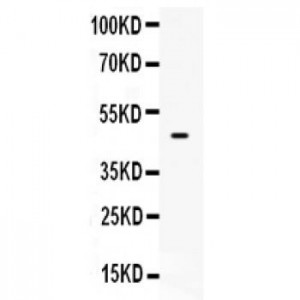More info
Overview
Long Name | Antibody Type | Antibody Isotype | Host | Species Reactivity | Validated Applications | Purification |
| phosphatase and tensin homolog | Polyclonal | IgG | Rabbit | Human, Rat | WB | Immunogen affinity purified. |
Immunogen | ||||||
| E.coli-derived human PTEN recombinant protein (Position: E91-V403). Human PTEN shares 99.7% amino acid (aa) sequence identity with mouse PTEN. | ||||||
Properties
Form | Lyophilized |
Size | 100 µg/vial |
Contents | Antibody is lyophilized with 5 mg BSA, 0.9 mg NaCl, 0.2 mg Na2HPO4, 0.05 mg NaN3. *carrier free antibody available upon request. |
Concentration | Reconstitute with 0.2 mL sterile dH2O (500 µg/ml final concentration). |
Storage | At -20 °C for 12 months, as supplied. Store reconstituted antibody at 2-8 °C for one month. For long-term storage, aliquot and store at -20 °C. Avoid repeated freezing and thawing. |
Additional Information Regarding the Antigen
Gene | PTEN |
Protein | Phosphatidylinositol 3,4,5-trisphosphate 3-phosphatase and dual-specificity protein phosphatase PTEN |
Uniprot ID | P60484 |
Function | Tumor suppressor. Acts as a dual-specificity protein phosphatase, dephosphorylating tyrosine-, serine- and threonine- phosphorylated proteins. Also acts as a lipid phosphatase, removing the phosphate in the D3 position of the inositol ring from phosphatidylinositol 3,4,5-trisphosphate, phosphatidylinositol 3,4-diphosphate, phosphatidylinositol 3- phosphate and inositol 1,3,4,5-tetrakisphosphate with order of substrate preference in vitro PtdIns(3,4,5)P3 > PtdIns(3,4)P2 > PtdIns3P > Ins(1,3,4,5)P4. The lipid phosphatase activity is critical for its tumor suppressor function. Antagonizes the PI3K- AKT/PKB signaling pathway by dephosphorylating phosphoinositides and thereby modulating cell cycle progression and cell survival. The unphosphorylated form cooperates with AIP1 to suppress AKT1 activation. Dephosphorylates tyrosine-phosphorylated focal adhesion kinase and inhibits cell migration and integrin-mediated cell spreading and focal adhesion formation. Plays a role as a key modulator of the AKT-mTOR signaling pathway controlling the tempo of the process of newborn neurons integration during adult neurogenesis, including correct neuron positioning, dendritic development and synapse formation. May be a negative regulator of insulin signaling and glucose metabolism in adipose tissue. The nuclear monoubiquitinated form possesses greater apoptotic potential, whereas the cytoplasmic nonubiquitinated form induces less tumor suppressive ability. In motile cells, suppresses the formation of lateral pseudopods and thereby promotes cell polarization and directed movement. |
Tissue Specificity | Expressed at a relatively high level in all adult tissues, including heart, brain, placenta, lung, liver, muscle, kidney and pancreas. |
Sub-cellular localization | Cytoplasm. Nucleus. Nucleus, PML body. Note: Monoubiquitinated form is nuclear. Nonubiquitinated form is cytoplasmic. Colocalized with PML and USP7 in PML nuclear bodies. XIAP/BIRC4 promotes its nuclear localization. |
Sequence Similarities | Contains 1 C2 tensin-type domain. |
Aliases | 10q23del antibody|Bannayan Zonana syndrome antibody|BZS antibody|DEC antibody|GLM2 antibody|ITGA 2 antibody|MGC11227 antibody|MHAM antibody| MMAC 1 antibody|MMAC1 antibody|MMAC1 phosphatase and tensin homolog deleted on chromosome 10 antibody|Multiple hamartoma (Cowden syndrome) antibody|Mutated in multiple advanced cancers 1 antibody|Mutated in Mutiple Advanced Cancers 1 antibody|Phosphatase and Tensin Homolog antibody| Phosphatase and tensin like protein antibody|Phosphatidylinositol 345 trisphosphate 3 phosphatase and dual specificity protein phosphatase PTEN antibody|Phosphatidylinositol 345 trisphosphate 3 phosphatase antibody| Phosphatidylinositol-3,4,5-trisphosphate 3 phosphatase and dual-specificity protein phosphatase PTEN antibody|Platelet antigen BR antibody|PTEN 1 antibody|Pten antibody|PTEN_HUMAN antibody|PTEN1 antibody|Tensin homolog antibody|TEP 1 antibody|TEP1 antibody|VLA 2 Receptor Alpha Subunit antibody |
Application Details
| Application | Concentration* | Species | Validated Using** |
| Western blot | 0.1-0.5μg/ml | Rat Human | AssaySolutio's ECL kit |
AssaySolution recommends Rabbit Chemiluminescent WB Detection Kit (AKIT001B) for Western blot. *Blocking peptide can be purchased at $65. Contact us for more information

Anti- PTEN antibody, ASA-B1593, Western blotting
All lanes: Anti PTEN (ASA-B1593) at 0.5ug/ml
WB: Rat Brain Tissue Lysate at 50ug
Predicted bind size: 47KD
Observed bind size: 47KD
All lanes: Anti PTEN (ASA-B1593) at 0.5ug/ml
WB: Rat Brain Tissue Lysate at 50ug
Predicted bind size: 47KD
Observed bind size: 47KD



